The Peoples of Tamriel: Elves
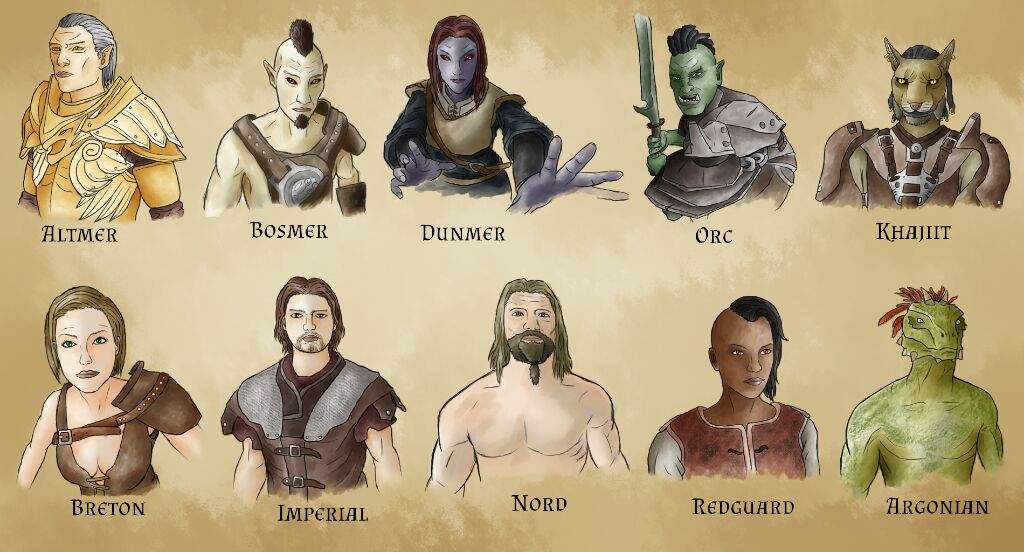
This is the second post in a series about the bringing peoples of Tamriel to a GURPS fantasy game. This post deals with elves, just as the first one dealt with humans.
Elves in Tamriel
As it happens in most fantasy settings, the Elves of Tamriel1 are a bit taller than its humans on average, and have large almond-shaped eyes and pointy ears. They’re also more inherently magical than humans, though that extra magic tends to conform itself to the environment a given elven people occupies over time.
Like humans, each elven people is associated with a different region of Tamriel, briefly described in their template. Each template also includes “typical” cultural traits and adventuring professions for a native of that region, which could apply to anyone born there.
Most elven people live much longer than humans, but in a typical Dungeon Fantasy campaign that’s not worth any points2.
Altmer (25 Points)
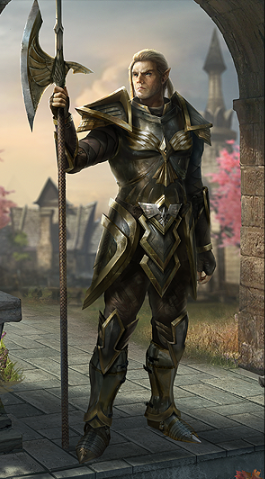
High Elves in all settings tend to have a reputation as snobs, and these guys are no exception. Altmer are on average taller than humans, with golden skin and white or golden hair. Their eyes are usually gold, amber or green in color.
Altmer are the original elves, at least according to their own traditions. All the other elven peoples originated from groups of Altmer dissidents who left their homeland of Summerset Isle and migrated elsewhere. While individual High Elves vary a lot in their outlook, the highly stratified society of Summerset Island is founded on the idea that they’re better than everyone else.
Altmer religion teaches they are the direct descendants of gods who were tricked into giving up their divinity so the world could be created. They ruled a continent-spanning empire in Tamriel long before humans arrived on the scene, and the islands don’t lack for extremists who want to bring the good old days back at the expense of everyone else. The latest of these are the fascist Thalmor, who by the events of Skyrim are alarmingly close to conquering Tamriel.
The younger generations tend to be much more egalitarian and open-minded, as do Altmer of all ages who live outside of Summerset. Their innate facility with magic and the wide availability of quality training in Summerset means Altmer adventurers are commonly Wizards or members of other spellcasting professions (like, say, Magic Archers). Even High Elves who are nominally knights or swashbucklers know a few spells.
Advantages: Magery 1 {15}; Energy Reserve (Magical) 3 {9}; Better Power Items {1}.
Other Traits: Some level of Intolerance is extremely common among Thalmor members, and even those Altmer who oppose their ideology might still be prone to bouts of well-meaning condescension that translate into an Odious Personal Habit.
Bosmer (25 points)
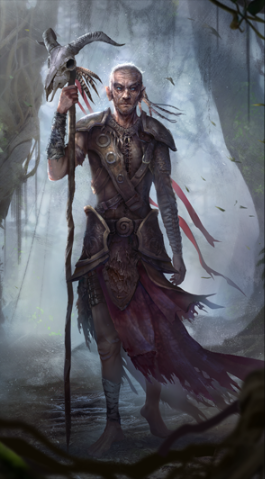
Bosmer or Wood Elves call the temperate, heavily-forested province of Valenwood their home. Their appearance and behavior are pretty much those of cliche wood elves from other settings: they’re all about archery and protecting their forest homes.
Many Valenwood Bosmer go even beyond the cliche by becoming members of the Green Pact, a religious philosophy that exhorts them to avoid harming plants and natural environments, never take the shape of beasts, and never kill wastefully. Green Pact followers are strict carnivores who feel morally obligated to eat or otherwise make use everything they kill - for the most extreme among them, that includes people. They can’t make any objects from plant matter, but can use those made by others just fine.
Scouts and Druids are by far the most popular professions for Bosmer adventurers.
Advantages: Animal Empathy {5}; Animal Friend {5}; Forest Guardian 2 {10}; Resistant to Poison +3 {5}.
Other Traits: Disciplines of Faith (Green Pact) is worth -15 points and is common in Valendood proper. Green Pact extremists also have Odious Personal Habit (Cannibal) for another -15 points and a -3 to reactions from anyone who is not similarly inclined. This should probably be restricted to NPCs. Bosmer PCs might also opt to take plain old Sense of Duty (Nature) instead or not take any of these disadvantages at all, particularly if they were raised outside of Valenwood.
Dunmer (20 points)
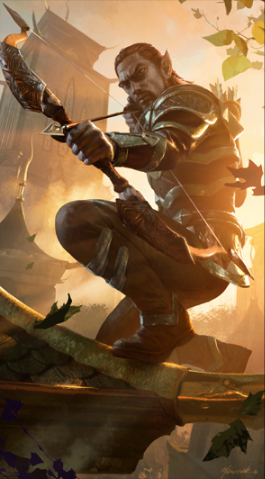
Dunmer, also known as Dark Elves, have ash-colored skin, black, dark brown or white hair, and red or amber eyes. They hail from the volcanic land of Morrowind, which they share with giant mushrooms, giant insects, and a whole lot of ash. They are widely known as fierce warriors and aggressive spellcasters, shaped by their harsh environment and cutthroat politics.
Morrowind is dominated by four noble houses who divide the important functions of society among themselves. Needless to say, they constantly scheme against each other: this is a realm whose premier law enforcement agency is a guild of assassins. They spent much of their history worshipping a pantheon that was basically an ascended adventuring party. After the events of Morrowind they mostly revert back to their old gods. In both cases ancestor worship remains an important component of their religion.
Dunmer adventurers tend to be Knights and Wizards, or professions that combine both (like the Mystic Knights from Pyramid #3/13). Thieves and Assassins (or even Ninja!) are also common. Your typical Dunmer wizard tends to prefer elements other than fire for their damage spells, since they expect to be slinging those at other Dunmer in the course of their many violent intrigues. Their tradition of ancestor worship means necromancy is looked upon a lot more favorably in Morrowind than it is elsewhere.
Advantages: Damage Resistance (Limited, Heat/Fire -40%) 5 {15}; Magery 0 {5}.
Other Traits: Getting your PCs tangled in Dunmer House politics is an excellent way to introduce all sorts of social traits like Enemies, Allies, Secrets, Patrons and Contacts in a game that didn’t include them previously.
Orsimer (21 points)
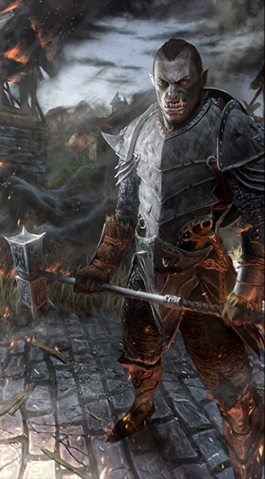
In Tamriel, Orcs are Elves too! They were almost universally reviled for a long time, but their loyal service to the Empire over the years earned them acceptance. They look big, green, and tusky, and unlike other Mer live about as long as humans.
The orcish homeland isn’t an official province, but rather a series of mountain ranges that falls within High Rock, Skyrim and Valenwood. Their capital is the city of Orsinium, which has been sacked and rebuilt multiple times in different locations throughout the history of Tamriel. Traditional orcish culture makes Nords seem like peace-loving softies. They basically worship the God of Having A Chip on Your Shoulder.
Orcish adventurers favor big, brawny professions like Knight and Barbarian, though orcish Artificers are also surprisingly common and tend to specialize either in smithing or in alchemy.
Advantages: Focused Fury {1}; Great Rage 1 {20}.
Other Traits: Both advantages above are from Dungeon Fantasy Denizens: Barbarians. If the campaign takes place in a time or place where orcs are particularly reviled, they would also have an appropriate Social Stigma. Like Nords, though, orcish Barbarians in campaigns taking place in their homeland aren’t considered a Minority Group. Some level of Berserk is quite common, though.
Other Elves
The templates above are just for the elves that have been traditionally playable in Elder Scrolls games. There are many, many more:
- In Tamriel, dwarves are elves! The Dwemer vanished way back in the First Age and left a whole bunch of extensive, steam-powered underground complexes whose advanced machinery is still pumping after all these millenia.
- The Falmer, or Snow Elves, dominated Skyrim at the dawn of the First Age and were displaced by the conquering Nords. This led to an ill-fated deal with the Dwemer that eventually turned most of them into blind cave-dwelling cannibals.
As usual for Dungeon Fantasy, every time your PCs think they know all elven subtypes, feel free to introduce a couple more.